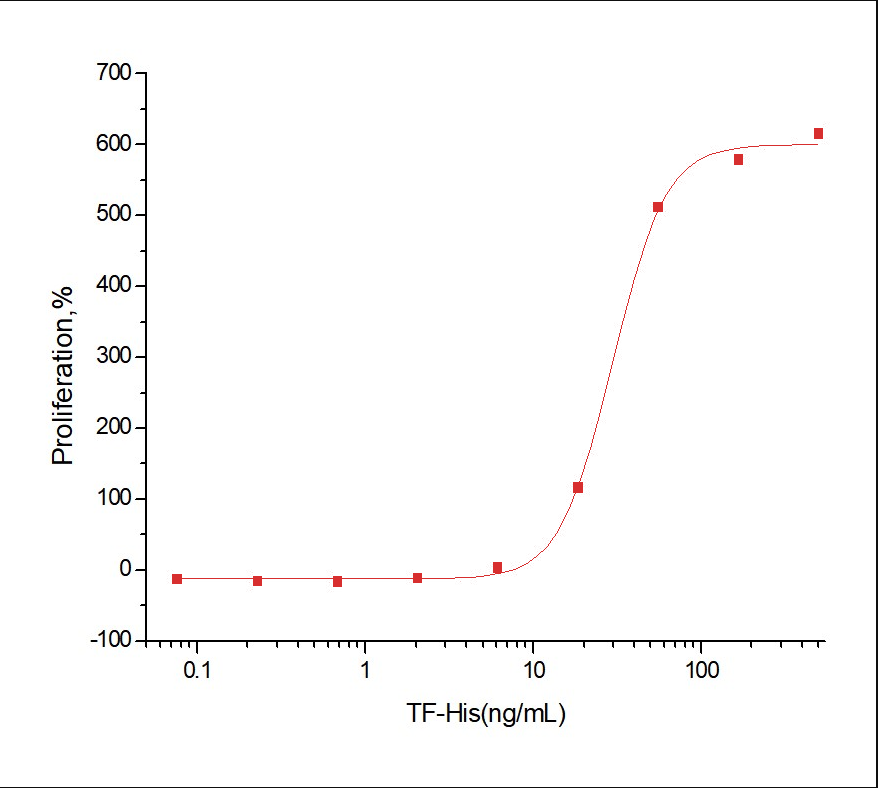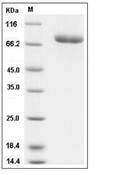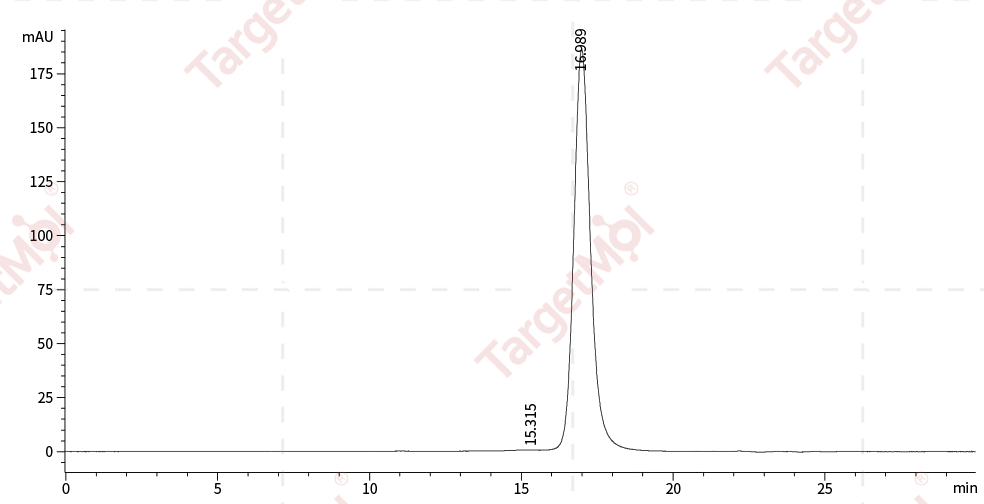Shopping Cart
- Remove All
 Your shopping cart is currently empty
Your shopping cart is currently empty
Transferrin Protein, Human, Recombinant (His) is expressed in HEK293 mammalian cells with His tag. The predicted molecular weight is 76.6 kDa and the accession number is P02787.

| Pack Size | Price | Availability | Quantity |
|---|---|---|---|
| 5 μg | $42 | 7-10 days | |
| 10 μg | $64 | 7-10 days | |
| 20 μg | $98 | 7-10 days | |
| 50 μg | $195 | 7-10 days | |
| 100 μg | $325 | In Stock | |
| 200 μg | $576 | 7-10 days | |
| 500 μg | $1,220 | 7-10 days |
| Biological Activity | 1. Measured by its binding ability in a functional ELISA. Immobilized human CD71 at 10 μg/ml (100 μl/well) can bind human Transferrin. The EC50 of human Transferrin is 5.6 ng/mL.
2. Measured in a serum-free cell proliferation assay using MCF-7 human breast cancer cells. Karey, K.P. et al. (1988) Cancer Research 48:4083. The ED50 for this effect is typically 0.01-0.04 μg/mL.  |
| Description | Transferrin Protein, Human, Recombinant (His) is expressed in HEK293 mammalian cells with His tag. The predicted molecular weight is 76.6 kDa and the accession number is P02787. |
| Species | Human |
| Expression System | HEK293 Cells |
| Tag | C-His |
| Accession Number | P02787 |
| Synonyms | transferrin,TFQTL1,PRO2086,PRO1557,HEL-S-71p |
| Construction | A DNA sequence encoding the human transferrin (NP_001054.1) (Met 1-Pro 698) was fused with a polyhistidine tag at the C-terminus. Predicted N terminal: Val 20 |
| Protein Purity | ≥ 95 % as determined by SDS-PAGE ≥ 95 % as determined by SEC-HPLC.   |
| Molecular Weight | 76.6 kDa (predicted); 74 kDa (reducing condition, due to glycosylation) |
| Endotoxin | < 1.0 EU/μg of the protein as determined by the LAL method. |
| Formulation | Lyophilized from a solution filtered through a 0.22 μm filter, containing PBS, pH 7.4. Typically, a mixture containing 5% to 8% trehalose, mannitol, and 0.01% Tween 80 is incorporated as a protective agent before lyophilization. |
| Reconstitution | A Certificate of Analysis (CoA) containing reconstitution instructions is included with the products. Please refer to the CoA for detailed information. |
| Stability & Storage | It is recommended to store recombinant proteins at -20°C to -80°C for future use. Lyophilized powders can be stably stored for over 12 months, while liquid products can be stored for 6-12 months at -80°C. For reconstituted protein solutions, the solution can be stored at -20°C to -80°C for at least 3 months. Please avoid multiple freeze-thaw cycles and store products in aliquots. |
| Shipping | In general, Lyophilized powders are shipping with blue ice. |
| Research Background | Transferrin is a glycoprotein with an approximate molecular weight of 76.5 kDa. This glycoprotein is thought to have been created as a result of an ancient gene duplication event that led to generation of homologous C and N-terminal domains each of which binds one ion of ferric iron. The function of Transferrin is to transport iron from the intestine, reticuloendothelial system, and liver parenchymal cells to all proliferating cells in the body. This protein may also have a physiologic role as granulocyte / pollen-binding protein (GPBP) involved in the removal of certain organic matter and allergens from serum. Transferrins are iron binding transport proteins that bind Fe3+ion in association with the binding of an anion, usually bicarbonate. This transferrin binds only one Fe3+ion per protein molecule. Transports iron ions from the hemolymph into the eggs during the vitellogenic stage. Transferrins are iron binding transport proteins which can bind two Fe(3+) ions in association with the binding of an anion, usually bicarbonate. It is responsible for the transport of iron from sites of absorption and heme degradation to those of storage and utilization. Serum transferrin may also have a further role in stimulating cell proliferation. When a transferrin loaded with iron encounters with a transferring receptor on cell surface, transferring binds to it and, as a consequence, is transported into the cell in a visicle by receptor-mediated endocytosis. The PH is reduced by hydrogen iron pumps. The lower pH causes transferrin to release its iron ions. The receptor is then transported through the endocytic cycle back to the cell surface, ready for another round of iron uptake. Each transferrin molecule has the ability to carry two iron ions in the ferric form. |

Copyright © 2015-2025 TargetMol Chemicals Inc. All Rights Reserved.